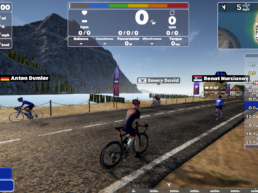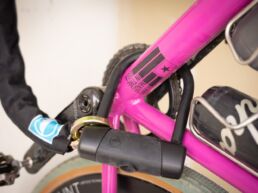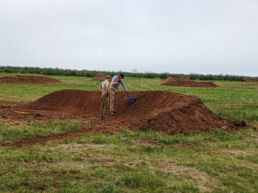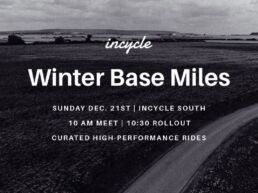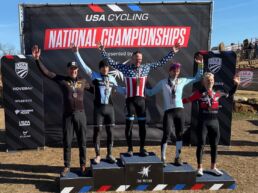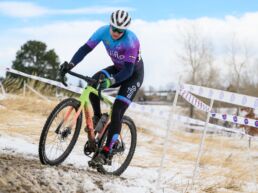Marie Walsh’s FKT on the Kitchen Sink Loop
In the early hours of the morning, of July 25th at 1:34 a.m., Marie Walsh rolled back into Fort Collins having completed the full Kitchen Sink Loop—445 miles and over 43,000 feet of climbing—in 5 days, 17 hours, and 56 minutes. Exhausted but proud, Marie became the first rider to set a Fastest Known Time (FKT) on the route.
The Kitchen Sink Loop itself was created by local cyclist Scott Ruff (kitchensinkloop.org) and links together some of Northern Colorado’s most demanding and rewarding terrain: rugged jeep roads, iconic climbs, high alpine passes, sweeping descents, and remote campsites. Designed to push limits while showcasing the best of Colorado’s backcountry, it delivers equal measures of challenge and beauty.
Rather than coming up with her own interview prompts, Marie turned to her community. She asked her friends on Facebook what questions they wanted answered about her ride—and their curiosity shaped the Q&A that follows. Paired with images from her adventure, Marie shares the highs, lows, and unforgettable moments from her five-and-a-half days on the Kitchen Sink Loop.
15 Questions About My Bikepacking Journey Answered
Thank you to everyone who contributed by asking thoughtful questions and offering encouragement as I put together this Q&A-style write-up about my most recent adventure on the Kitchen Sink Loop. Your curiosity and support helped me reflect more deeply on the experience and share it in a way that feels both personal and informative. Hope you enjoy!!
1. “What is it?”
The Kitchen Sink Loop is a 445-mile bikepacking route in Northern Colorado that begins and ends in Fort Collins. Designed for adventure cyclists, the route primarily follows dirt and gravel forest service roads, with sections of high-quality singletrack woven in for added challenge and variety. It offers a diverse riding experience through scenic landscapes, remote areas, and even includes 3 different opportunities to soak in hot springs—making it a truly unique and rewarding journey.
The route is thoroughly documented at kitchensinkloop.org, where riders can find detailed maps, stunning photos, and comprehensive resources for camping, water, food, and services. The site also includes a downloadable PDF with a suggested itinerary for an 11-day trip, as well as alternate route options to help make the loop more accessible to gravel bikes by bypassing the more technically difficult trails.
2. “Could ordinary mortals do it?”
That’s actually the beauty of the Kitchen Sink Loop—it’s a bikepacking route that’s not just for elite athletes or ultra-endurance riders. It’s absolutely achievable for any intermediate-level bikepacker, and with a few modifications, even beginner riders can take on sections of it to get a taste of what bikepacking is all about.
By following the suggested 11-day itinerary outlined at kitchensinkloop.org, riders can plan their days to end at hotels or established campsites, making the experience more comfortable and accessible. The route’s proximity to towns, convenience stores, and other services adds a layer of safety and flexibility, to carry about 2 days of food if following the 11-day itinerary. From a safety standpoint, you’re never too far from a road accessible by motor vehicles, which means that assistance—whether for medical or mechanical issues—is always within reach.
This flexibility makes the Kitchen Sink Loop a welcoming and rewarding experience for “ordinary mortals” and seasoned riders alike.
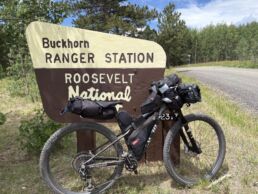
3. “How far and how many miles to do it right every day?”
The Kitchen Sink Loop can be approached in many ways to suit different experience levels and schedules. For the best pace that includes good camping, food, beer, hot springs and resupply every couple of days, I highly recommend following the 11-day itinerary suggested at kitchensinkloop.org.
Alternatively, the route can be broken into segments and tackled one weekend at a time, following the sections outlined in the downloadable PDF on kitchensinkloop.org. This flexibility makes the loop accessible to a wide range of riders, whether you’re aiming for a continuous adventure or a series of shorter, manageable outings.
4. “What kind of gear did you use?”
For this bikepacking trip, I went with an ultralight setup that prioritized performance, durability, and a few well-earned comforts. I rode the Specialized Epic World Cup, outfitted with Traverse SL wheels—heavier than what I normally ride because I wanted them to be tough enough to handle rugged terrain with confidence. For tires, I ran the newest version of the Fast Trak Grid Light.
The drivetrain featured a 30-tooth chainring up front with a standard gear range on the rear cassette (10-52), paired with the SRAM XX electronic transmission, which I was using for the first time on a bikepacking adventure. The electronic shifting was smooth and reliable, even under load, and added a layer of efficiency to the ride. Thankfully, I did carry an extra battery because I did have to replace it somewhere near Eldora.
Suspension included 120 mm of front travel and 80 mm in the rear, striking a great balance between control and comfort.
One of the standout pieces of gear was the Rogue Panda Ripsey seat bag. It’s a harness-style system with up to 8 liters of volume, which allowed me to bring a bivy tent and a small sleeping bag—luxuries compared to my usual tarp and bivy sack sleep system.
Despite these additions, the overall setup remained ultralight, enabling me to stay fast and nimble without sacrificing rest and recovery.
This trip marked a thoughtful evolution in my bikepacking approach: still minimalist and weight-conscious, but with a few strategic upgrades that made the experience more enjoyable and sustainable over longer distances.
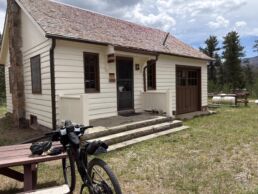
5. “What food did you eat?”
For this bikepacking trip, I actually took a much more disciplined and calculated approach to nutrition than I have in the past. I’m ballpark guessing I consumed about 4,500-5,500 calories a day, which really feels like a lot of food to me. I was intentional about fueling consistently, aiming to consume at least 100 calories every 20 to 30 minutes. To support this, I relied on Tailwind Nutrition as my primary hydration source early in the trip, switching to Skratch Labs after resupplying in Winter Park. These hydration mixes helped me stay on top of both fluid and calorie intake, making it easier to maintain energy levels throughout long days on the bike.
In addition to liquid nutrition, I packed a variety of snacks that were easy to access and digest while riding: Larabars, Honey Stinger waffles and chews, fruit leathers, chocolate-covered almonds, and animal crackers. I also left room for flexibility, picking up whatever sounded good at gas stations and convenience stores during resupply stops. This mix of planned and spontaneous snacking helped me stay fueled and avoid palate fatigue.
For my main meals, I pre-made food using cold-soak recipes from Backcountry Foodie, which allowed me to ensure balanced nutrition without adding bulk to my ultralight setup. Also.. cold-soaking means space and weight saving because I didn’t need to bring a stove or fuel. Breakfast and lunch typically consisted of the chocolate peanut butter shake—a calorie-dense, protein-rich option that was easy to prepare and satisfying (free recipe here: https://backcountryfoodie.com/chocolate-peanut-butter-shake-backpacking-meal/). For dinner, I had prepared Backcountry Foodie’s Pesto Pasta, which offered a comforting and flavorful end to long days in the saddle. Pre-making these meals was a game-changer, giving me confidence that I was fueling well without relying on town stops.
Interestingly, I didn’t eat much when I was in town because I was already so full from constant snacking and hydration. But one meal stands out: in Hot Sulphur Springs, the hotel lobby offered a cold Caesar salad and a ham and cheese sandwich. After such a hard effort, even the wilted iceberg lettuce and brown edges of the salad tasted divine. The sandwich, topped with Caesar dressing, was unexpectedly euphoric—proof that sometimes, the simplest meals can feel like gourmet experiences when you’re deep in the effort.
6. “How did you hear about it? What motivated you to do it in the first place?”
What motivated me most on my recent bikepacking trip—the Kitchen Sink Loop—was the route itself and the person behind it: Scott Ruff. For years, I had been dreaming of a bikepacking route that would combine a soak in hot springs with a stretch of the iconic Tour Divide starting from my doorstep. I had tried piecing together a few routes on my own, but nothing quite fit. Then, just last year, Scott finished crafting the Kitchen Sink Loop, a route that included everything I had hoped for—and everything else, except the kitchen sink.
Scott isn’t just a passionate route builder—he’s a seasoned ride leader for the Adventure Cycling Association, having led tours through the Arkansas High Country, the Great Divide Route, and even Alaska. His personal bikepacking resume includes ambitious routes like the Tour Divide, Carretera Austral through Patagonia, the Baja Divide, the Colorado Trail, and many others. Knowing the depth of his experience gave me confidence in the route’s quality and challenge.
I don’t remember exactly how it came up, but at some point Scott suggested that I could attempt the first official FKT (Fastest Known Time) on the route. I had never held an FKT before, and the idea sparked something in me. For the past several years, I had stepped back from bikepack racing. Perimenopause had brought significant changes to my body and performance, and I had to scale back my ultra-endurance efforts. But the Kitchen Sink Loop felt different—it offered a way to gently reintroduce myself to bikepack racing in a way that felt achievable and less risky than past challenges like the Colorado Trail Race.
This ride wasn’t just about speed or competition—it was about reconnecting with a part of myself that had been quiet for a while. The route, the challenge, and the opportunity to set a first FKT all came together to create a powerful sense of purpose. It was a ride fueled by gratitude, curiosity, and the joy of rediscovery.
7. “Did you train beforehand? If so how much?”
The truth is, I didn’t train specifically for the Kitchen Sink Loop. Instead, I rely on a baseline level of fitness that allows me to take on these kinds of adventures in a spontaneous, last-minute kind of way. When I used to ride more competitively, I would intentionally go out for 10–20+ hour rides every two to three weeks, along with overnight bikepacking training rides. But over the past few years, perimenopause has changed how my body responds to those efforts—I found I wasn’t recovering well enough to stay healthy.
These days, I’ve shifted my training to focus more on sustainability and overall wellness. I still enjoy long rides, though now they happen maybe once every month or two. In between, I prioritize weight training, yoga, and shorter but more intense bike rides in the 2–4 hour range. So while I’m no longer training specifically for bikepack racing, I do work hard to maintain a level of fitness that keeps me ready for these kinds of adventures when the opportunity arises.
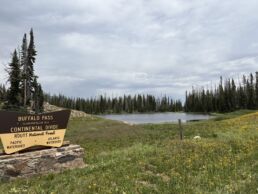
8. “What did you bring that you wish you had not and what did you leave home that you wished you had brought?”
Before the trip, I debated long and hard about whether to bring a small crochet project. I packed it, unpacked it, and packed it again in the days leading up to the ride. In the end, I did not bring my crochet with me. Most of my time bikepacking is spent riding, pushing the bike, eating, drinking, sleeping—and then repeating that cycle. Realistically, I knew I wouldn’t have much time to sit and crochet. But crochet is something that calms my mind, and there were definitely a few moments during the trip when I wished I had it with me. Just ten minutes of quiet stitching might have helped me reset when I was feeling stressed, overwhelmed, or tired.
Aside from that, I didn’t regret much of what I brought. Anything I truly needed was easy to access during resupply stops in town. For example, I picked up an extra set of AA batteries and a pair of warm gloves at a convenience store in Allenspark. The route’s accessibility made it easy to adapt on the fly, which meant I didn’t have to carry everything from the start—just the essentials.
9. “Did you wild camp every night? Where did you sleep every night? Did you sleep in a bathroom?”
I didn’t wild camp every night on the Kitchen Sink Loop, but I did on my first night—along Deadman Road in Red Feather, Colorado. I found a peaceful little site next to a brook near the winter closure gate, which made for a quiet and restorative start. On the second night, I stayed in a hotel in Walden, which was essential for tending to some saddle sores that were starting to develop.
Night three was spent at a designated campsite at Stagecoach Lake, about six miles south of Steamboat Springs. For night four, I stayed at the Hot Sulphur Springs Hotel—and that wasn’t just comfort, it was absolute luxury. After days of riding, soaking in the mineral springs and sleeping in a real bed felt like a dream. My final night was at Kelly Dahl Campground in Nederland, a quiet and convenient spot to wrap up the trip.
So no, I didn’t sleep in a bathroom—there were abundant campsites along the route, and I was able to plan each stop to avoid that kind of improvisation.
Even though I did indulge in hotels for 2 nights on this trip, it is entirely possible to do this trip more affordably with no hotels required. Both nights I stayed in a hotel, there was camping available nearby.
10. “What did you think about all day long?”
I laughed out loud with this question because, honestly, my brain is like a never-ending source of random thoughts and entertainment. It’s constantly playing some song—usually something unexpected—and I’m often bobbing my head to the music in my own mind. It’s pretty great, actually. I don’t need headphones or a playlist; my brain provides the soundtrack. And the random thoughts? They’re entertaining to say the least. My mind is like its own variety show—sometimes absurd, sometimes profound, and always active.
Being solitary for nearly six days straight gave me a lot of time to be in my own head. Sometimes that was fun and lighthearted—I’d get stuck on something silly that made me laugh or feel joyful. Other times, it got reflective, even a little dark. I’d think deeply about my relationships, about what I want to do with the rest of my life, and—more often than not—about my patients.
As a doctor, I carry a lot of concern for the people I care for. I found myself thinking about the hard things they’re going through, wondering if I’m handling their complex situations in the best way possible. That kind of mental processing doesn’t stop just because I’m on a bikepacking trip. In fact, the quiet and rhythm of riding often gives me more space to sit with those thoughts.
There were also moments when my mind turned to my friend who’s on hospice, dying from a brain tumor, surrounded by her children, husband, and loved ones.
Those thoughts were heavy and uncomfortable, but they felt important for me to sit with.
Part of what I love about long bikepacking adventures is that they create space for silence and solitude. The rhythm of pedaling through the landscape somehow makes it easier to sit with both the good and the hard things—to feel them fully and completely. And by the end of a ride like this, I often find myself arriving at a place of deeper understanding and peace.
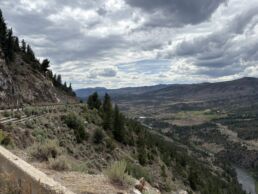
11. “How did you push through the tough times?”
It’s hard to describe how I push through the tough times because there’s no way to phrase it that truly captures how difficult it feels in the moment. On every bikepacking adventure, there comes a point where I feel ready to stop. I find myself wishing for a portal—something that could instantly transport me from wherever I am back home to my bed and to my daughter. In those moments, it’s hard to tell whether I’m just having a weak spell that will pass, or if I’ve genuinely reached a point where stopping is necessary for my health and safety. The truth is, it’s usually a mix of both.
Over time, I’ve developed a few strategies that help me push through:
1. Grounding in the present. I start by tuning into my senses. What can I see? What can I hear? What can I smell, taste, and feel? I take each sense one at a time, and this mindfulness practice helps anchor me in the moment. It reminds me that I’m still here, still capable, and still moving forward.
2. Gratitude. I make a mental list of small things I’m thankful for. Maybe my bike is working well, the tires are holding pressure, the weather is decent, or my socks are dry. I check in with my body—often I’m feeling okay in terms of energy and nutrition. I remind myself how lucky I am to have a body strong enough to do this, and to have people back home watching my dot, cheering me on, and hoping I’m safe and enjoying myself.
3. Small goals. I break the ride into manageable pieces. “Just get to the next town,” I tell myself. “If you still feel like quitting there, you can.” More often than not, I don’t.
4. Rest. When everything feels overwhelming, it’s usually a sign that I need rest. Sometimes a short nap or sitting on a rock for a few minutes is enough to restore my mental resilience. And when it’s really bad, I’ll put up my tent and go to bed early. Rest isn’t weakness—it’s wisdom.
5. Permission to quit. Sometimes, pushing through isn’t the answer. Our culture tends to glorify pushing past limits, even when it leads to harm. But there’s no prize for suffering. If it’s no longer fun, meaningful, or safe, it’s okay to stop. Quitting doesn’t mean I’m weak or not good enough—it might just mean that I’ve had the experience I needed, my cup is full, and I’m ready to return to real life.
Pushing through the tough times isn’t about being heroic—it’s about being honest with myself, listening to my body, and finding peace in whatever decision I make.
12. “Were you ever scared?”
Absolutely. With any bikepacking adventure, fear is part of the experience—right from the beginning. I was scared I wouldn’t be strong enough, scared I’d have a mechanical I couldn’t fix and end up stranded, scared of being chased by a bear or mountain lion, scared of running out of food or water, scared of getting hurt and having people ask, “What were you thinking?” And yes, scared of the dark—especially in mountain lion territory.
But fear isn’t always a bad thing. It keeps us alert, helps us plan and prepare, and reminds us to respect our limits. It’s part of what makes these adventures meaningful.
That said, there was one moment on this trip when I was truly terrified. I was riding Pierson Park Road near Meeker Park, racing against the sunset, knowing I’d be in the dark for at least an hour or two. Those who know me well know about my traumatic mountain lion encounter over a decade ago at Curt Gowdy State Park—so riding in the dark through heavily wooded terrain was already pushing my limits.
As twilight faded, I spotted a tan figure on the road ahead. At first, I hoped it was a dog from a nearby camper. But its smooth, deliberate movements and long tail told me otherwise. It was a mountain lion. I grabbed my fixed blade belt knife—the one I keep in the outside pocket of my handlebar feedbag for just such occasions. I made loud noises, tried to assert my presence, and kept my bike between us. The lion didn’t budge. It stared at me, calm and unafraid. Eventually, I began moving toward it, and after a few tense steps, it casually walked off the road and uphill, its eyes glowing in my headlamp beam.
Shaken, I continued up the climb until it appeared I had reached the descent portion of the ride. I resheathed my knife, remounted my bike, and began the high-speed descent—hoping my speed wouldn’t trigger the mountain lion’s chase instinct, as it had years ago at Curt Gowdy. But almost immediately, I realized there was another climb ahead. Hypervigilant, I scanned the woods constantly as I pushed my way—knife again in hand—up the next hill.
Luckily, I found a camper with a fire and asked if I could sit for a moment. His name was Philip, and he was also a bikepacker (he’d completed the TransAmerica Trail), so he understood what I was doing and didn’t think I was some crazy lady. He welcomed me, listened as I cried and composed myself, and even offered me a quesadilla. After riding Sourdough Trail in Nederland during a lightning, hail, and rainstorm, I still needed to change out of my soaked socks and waterproof liners (yes, they got soaked too) and put on warmer layers before descending the canyon. Philip gave me Ziploc bags to help keep my socks dry. His kindness helped me reset. Once I confirmed I was at the top of the final climb, I descended into Estes Park, hitting my top speed of 40 mph—adrenaline still pumping.
So yes, I was scared. But I kept going. Not because I wasn’t afraid—but because I was, and I knew how to move through it.
13. “How did you deal with pain/saddle source/any old nagging injuries that come with riding?”
When I’m not on the bike, I’m pretty dedicated to weight training, mobility work, and physical therapy—all of which help me stay strong and resilient for long rides. During this trip, I made sure to rest or sleep every night to support recovery. I do have some chronic neck and shoulder issues, so I’d take time each evening to stretch and massage those areas. One of my favorite tricks is using a 3L cylindrical stuff sack filled with rain gear and other soft items—it makes a surprisingly effective cervical pillow and gives my neck the support it needs.
The biggest challenge on this ride was saddle sores—something I’ve never really struggled with before. Normally, I might get a little irritation or swelling, but this time I developed actual blisters (bullae, if we’re being clinical) under my sit bones after the second day. I wasn’t entirely sure how to handle it, but I remembered hearing about Tour Divide riders using athletic tape.
Fortunately, I always carry a small medical kit with athletic tape, individually packaged wet wipes (the kind you find in hotels), and a healing ointment called Brave Soldier Antiseptic Healing Ointment (as Dude Dad would say, “Not a sponsor… yet”). Each night, I’d clean the area thoroughly, apply the ointment, and let it breathe. In the morning, I’d repeat the cleaning, apply a small amount of ointment, and cover the area with athletic tape. I also brought an extra chamois and ended up wearing two at once, strategically placing the second to offload pressure from the sore spots.
Surprisingly, the approach worked really well. It wasn’t perfect, but it kept me riding—and more importantly, kept me comfortable enough to enjoy the journey.
14. “What was your favorite part of your adventure?”
My favorite part of the Kitchen Sink Loop adventure was, without a doubt, reaching Hot Sulphur Springs. But what made it so memorable wasn’t just the destination—it was the wild, uncertain journey leading up to it.
After arriving in Radium, a small unincorporated community I’d love to revisit, I met a group of Tour Divide riders—six to eight of them—who had ridden there from Banff, Canada and were headed to the Mexican border at Antelope Wells, NM. As we approached Kremmling, they all veered off toward town, while I hesitated, contemplating whether to push forward toward Hot Sulphur Springs. My decision was met with surprise. A storm was rolling in, and the path ahead involved a 24-mile stretch with a 1,000-foot climb over the Parshall Divide. It was a gamble: race the storm, beat the sunset, and make it to the springs before they closed.
I had packed a swimsuit specifically for this moment. The hot springs were meant to be the crown jewel of my trip, and I wasn’t ready to let go of that vision. But as I pedaled up the pass, the clouds thickened and doubt crept in. I genuinely thought I might end up camping in the rain somewhere along the divide.
And then—relief. I made it. I arrived in Hot Sulphur Springs just in time, and the experience was nothing short of euphoric. Soaking in the warm mineral waters after such a grueling effort was pure bliss. I may have made a few people uncomfortable with the sheer joy on my face, but I didn’t care. That moment was the embodiment of everything I love about adventure: the risk, the perseverance, and the reward. It was a reminder that the most meaningful experiences often come after the hardest efforts.
15. “Any plans for longer rides like this one?”
While I’m not currently planning more bikepacking races or chasing FKTs, my focus has shifted toward shorter distances, slower paces, and savoring the journey—especially with good company. These days, I’m most excited about sharing bike adventures with my eight-year-old daughter, Addy, who recently expressed interest in bikepacking herself. It’s a whole new chapter: no longer the baby I could tow in a trailer, Addy now wants to carry her own gear and pedal under her own power. That brings a different kind of challenge, but also a deeper sense of connection and growth.
I’m open to route suggestions and always happy to have others join us—there’s something special about building community around shared exploration.
That said, I haven’t entirely let go of the dream of completing the Colorado Trail in one go. I’ve made five attempts, each falling short of my goal to finish it in under seven days. But as time goes on, the appeal of such intense efforts fades. They take a real toll on the body, and I find myself more drawn to experiences that nourish rather than exhaust

Who is this nutjob?
 Dr Marie Walsh is a Kaiser Permanent family medicine physician in Fort Collins who takes a holistic, preventive approach to care, with special interests in sports medicine, musculoskeletal injuries, and women’s health.
Dr Marie Walsh is a Kaiser Permanent family medicine physician in Fort Collins who takes a holistic, preventive approach to care, with special interests in sports medicine, musculoskeletal injuries, and women’s health.
Off the bike, she helps families thrive. On the bike, she’s known for big adventures—riding 24 hours up Horsetooth’s Towers climb (17+ laps, 30,000+ ft), a 200-mile day to the WY/CO/NE corner, a moonlit ride to RMNP’s Alpine Visitor Center and back, and multiple runs at the Colorado Trail Race—among other feats.
If you enjoy this content and appreciate the hustle that goes into YGR please consider supporting the site.

